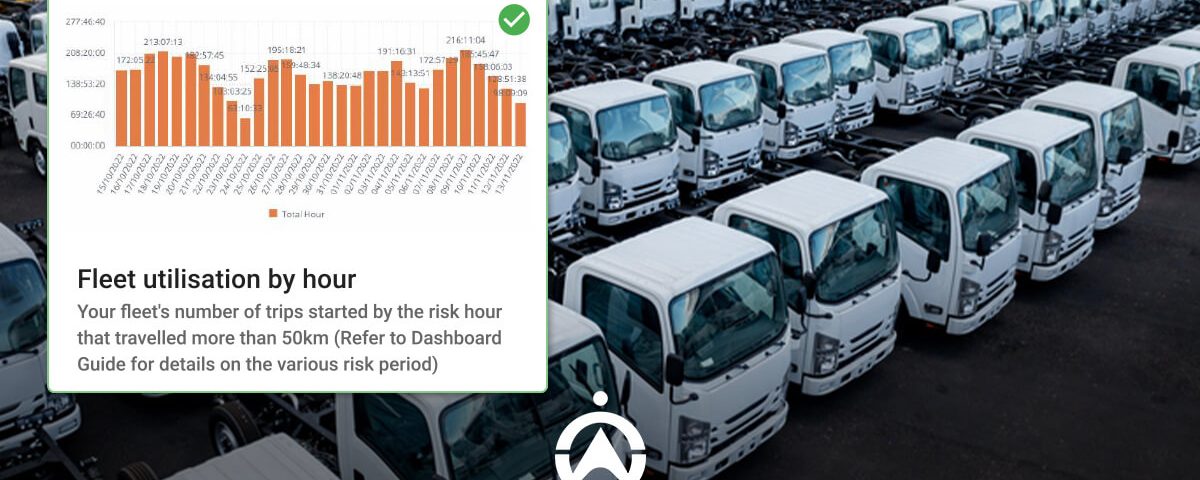What Exactly Is a Fleet Utilisation Rate?
A fleet utilisation rate shows how well a company uses its vehicles by comparing the time they spend on productive tasks to their total available time or capacity. It might sound very technical, but fleet utilisation impacts every aspect of your operation.
Whether you’re overseeing 10 vans or 500 trucks, understanding how effectively you’re using your vehicles can save you money, reduce downtime, and enable you to make smarter business decisions. Vehicles can easily sit idle, and many don’t realise the cost to your business. Fuel, insurance, and maintenance keep ticking away, even when a vehicle isn’t on the move.
That’s why tracking your usage is essential.
According to The DDC Group, fleet asset utilisation (or just fleet utilisation) measures how much demand there is for an organisation’s fleet against its capacity. Typically, it’s shown as a percentage. Most organisations target a utilisation rate of 80% or more to achieve peak efficiency.
In this blog, we’ll break down what a fleet utilisation rate is, how to calculate it, what optimal looks like, and how Cartrack’s platform can help you boost it with real-time data and insights.
What is a fleet utilisation rate?
A fleet utilisation rate shows how effectively you’re using your available fleet’s capacity. Simply put, it’s the percentage of time, mileage, or vehicles that are actually in use compared to what you have on hand. This metric helps you determine whether you’re making the most of your assets or overdoing it.
Why does fleet utilisation matter?
Knowing your utilisation rate helps you quickly identify inefficiencies. Low utilisation usually indicates an excess of vehicles or poor scheduling. While high utilisation might seem positive, it can cause wear and tear, rushed maintenance, or driver fatigue. Striking the right balance safeguards your budget and your team.
Common mistakes when measuring utilisation?
Many fleets miss the mark on utilisation because they focus solely on one metric (such as kilometres driven). True utilisation takes into account downtime, maintenance, and seasonal trends. Overlooking these aspects creates a misleading picture of performance and can lead to costly mistakes, such as purchasing more vehicles than necessary.
How do you calculate YOUR fleet utilisation rate?
You calculate your fleet’s utilisation rate by comparing active use with total availability, so you can identify idle assets, balance workloads, and boost overall efficiency. This helps you to see how effectively your vehicles are being used. The numbers are straightforward, and the insights are invaluable.
To easily calculate your fleet utilisation rate, use this formula:
Fleet Utilisation Rate (%) = (Total Used Hours ÷ Total Available Hours) × 100
This calculation shows the percentage of your fleet’s potential that’s actually in action. You can apply the same principle to kilometres, jobs, or vehicle count, depending on how your business runs.
Alternative ways to calculate utilisation
You’ve got a few ways to measure usage, depending on what matters most to your business.
- By vehicle count:
Take the number of vehicles in use and divide it by your entire fleet. This method works well when you want to keep an eye on how many assets are currently in action.
- By distance:
Divide the total kilometres driven by the maximum possible. This approach is great for assessing travel efficiency based on distance.
- By time:
Calculate hours in action divided by available hours remaining. This is the go-to method for service fleets that prioritise work time.
No matter which method you pick, it all boils down to your goals. Time-based formulas suit service fleets, while mileage-based ones are ideal for logistics operations.
Example: Calculating utilisation for a 10-vehicle fleet
Check this out: Imagine you have 10 vehicles, each ready to roll for 8 hours a day. That gives you a total of 80 available hours. If they clock in 56 hours of usage, your fleet utilisation rate hits 70%.
Typical calculation mistakes
Don’t forget to account for the time when vehicles aren’t on hand. If they’re in the garage or waiting for parts, they’re simply not “available”. Make sure your data spans the same time frame; mixing daily and weekly figures can throw off your results and misrepresent actual performance—whether it’s good or bad.
.jpeg)
What is a good utilisation rate?
A good utilisation rate maintains its utilisation rates between 70% and 85%. Going over 85% could strain your fleet, while lower rates suggest underutilisation or poor scheduling. The ideal rate really depends on your fleet size, industry, and the flexibility needed for daily operations.
A “good” utilisation rate varies from fleet to fleet. It depends on your industry, operating model, and business objectives. In this section, we’ll dive into the average utilisation benchmarks, examine the factors that impact your rate, and demonstrate how to enhance it using real-time data and savvy planning.
Factors that influence utilisation
Utilisation rates can fluctuate due to driver behaviour, vehicle downtime, scheduled maintenance, and demand patterns. Seasonal activities and route planning also play a role in usage rates. Keeping an eye on these factors allows you to tackle potential utilisation issues before they turn into costly problems.
How to improve your utilisation rate
Improving utilisation begins with visibility. By leveraging telematics, route optimisation, and data-driven schedules, you can maximise the value from each vehicle in service. Spotting idle time and managing workloads effectively helps you avoid unnecessary vehicles and keeps your workforce lean.
Drivers and barriers to achieving high fleet utilisation
There are certain drivers and barriers that play a role in achieving a high fleet utilisation rate. To truly maximise your fleet, you need to do more than just increase driving time. Smart route planning, predictive maintenance, and real-time tracking make a real difference. Watch out for hurdles like poor scheduling, idle time between jobs, and unexpected downtime.
By leveraging connected fleet data, you can pinpoint issues and resolve them quickly.
Connect people, data, and technology, and your fleet transforms from mere vehicles into a well-coordinated, cost-effective operation. With Cartrack’s fleet management platform, you gain clear insights into how each asset impacts your bottom line, empowering you to make smarter, quicker decisions that deliver real results.
Practical steps to improve fleet utilisation
Practical steps you can take to improve your fleet utilisation include:
- data-informed planning
- driving engagement
- predictive maintenance
- on-demand monitoring
Remember, maximising your fleet utilisation doesn’t always mean buying new vehicles; it’s all about unlocking the full potential of your EXISTING fleet.
Start with a fleet audit
Start by taking a good look at how you’re currently using your vehicles. Identify which ones aren’t getting enough use and which ones are stretched too thin. A straightforward audit gives you a solid foundation and the confidence to make decisions based on actual data, not just guesswork.
Right-size your fleet
If you’ve got too many vehicles, you’re tying up unnecessary capital in assets you might not need. Selling or reallocating underperforming vehicles will ease cash flow and boost overall utilisation without adding extra work.
Optimise scheduling and routes
Even the tiniest tweaks to jobs and routes can make a big difference. Embracing route optimisation software helps you cut down on empty kilometres, ensure timely deliveries,
and keep your vehicles busy generating revenue instead of sitting idle.
.jpeg)
Reduce downtime with predictive maintenance
Keeping your vehicles well-maintained helps you manage unscheduled maintenance that can affect availability. Predictive maintenance takes it further by using data to spot potential issues from vehicle usage, allowing you to plan repairs with minimal disruption rather than facing emergency downtime.
Use telematics to track real-time performance
Today’s telematics platforms, like Cartrack, enhance your visibility into how, when, and where your fleet vehicles are used. You can easily monitor driver behaviours, idle time, and routing patterns all from one dashboard. This data gives you the power to make immediate adjustments to workloads and spot trends with minimal delay.
Continuously review and improve
Your fleet’s performance isn’t set in stone. By reviewing utilisation monthly or quarterly, you’ll gain insights into seasonal shifts and evolving customer demands. Your aim? Keep your fleet busy, efficient, and well-maintained.
Integrating with Cartrack
Cartrack helps you track and boost your fleet utilisation effortlessly. With our platform, you get everything you need to keep your fleet running at its best. You can easily monitor real-time usage data, track downtime, and access instant insights about vehicles that aren’t pulling their weight, all from one user-friendly dashboard.
Turn your data into actionable fleet intelligence instead of making wild guesses. Cartrack integrates this intelligence into your decision-making process. You’ll know exactly when to reassign vehicles, schedule maintenance, or adjust the size of your fleet. It’s all about using telematics data to create a solid strategy and ensuring every vehicle in your fleet contributes to your success.
Understanding your fleet utilisation rate is key to boosting efficiency and profit. By assessing how much of your fleet capacity you’re truly using, you can optimise your operations, cut costs, and enhance performance.
With Cartrack, you’ll gain clear insights into how effectively your fleet operates and where to direct your improvement efforts next.
FAQs
What’s the difference between fleet utilisation and fleet productivity?
Fleet utilisation measures how much of your fleet is being used, while fleet productivity focuses on how efficiently those vehicles perform tasks. You can have high utilisation but low productivity if routes are inefficient, vehicles are overloaded, or drivers spend too much time idling between jobs.
Can you measure utilisation across mixed vehicle types?
Yes, you can calculate utilisation separately for each vehicle type, such as vans, trucks, or specialised assets, and then combine the results for a total fleet average. Telematics tools make this easy by tracking mileage, trip frequency, and time in use for every vehicle in real time.
How often should you review your fleet utilisation rate?
Most fleet managers review utilisation monthly to spot short-term trends, then assess it quarterly for strategic planning. Regular reviews help you balance workloads, identify underused vehicles, and plan maintenance before issues impact performance or costs, keeping your fleet efficient and your operations running smoothly.
What data sources do you need to measure utilisation accurately?
Accurate utilisation depends on reliable data. The most common sources include GPS tracking, telematics systems, fuel records, maintenance logs, and driver trip data. When combined, these give a complete picture of when, how, and how often each vehicle is used, helping you make smarter operational decisions.
Can poor utilisation affect your fleet’s resale value?
Yes, vehicles that sit idle for long periods can deteriorate mechanically, while overused ones experience faster wear and tear. Both reduce resale value. Balanced utilisation, supported by proactive maintenance, helps preserve asset condition, extend vehicle lifespan, and achieve better trade-in or resale prices over time.
How can technology predict future utilisation trends?
Modern fleet platforms analyse historical usage patterns, driver behaviour, and seasonal demand to forecast utilisation trends. This helps managers predict when assets will be underused or overworked, allowing smarter scheduling and procurement decisions that keep fleets lean, productive, and aligned with business demand throughout the year.




